What attracts us to certain birds? What gets us more excited when we see and interact with some species? Colors, size, shape, overall look, behaviors, birds we rarely see, birds with a trusting nature that allow us to spend time with them in close proximity, birds that endear themselves in some way - or is it some combination of these qualities? I didn’t expect it in advance, but American Oystercatchers really caught my attention and made quite an impression when I first photographed them.
I enjoyed my first close experiences with a trusting pair of American Oystercatchers almost a year ago, last February first. My brother Jim found and photographed the birds the previous December and when I visited a couple months later, my first chance to photograph in the Tampa area was during a day trip with Jim and Rose to Fort DeSoto State Park south of St. Petersburg. The first birds we encountered aside from Ospreys were the same pair of oystercatchers, as evidenced by the banded female; they were essentially in the same location as Jim originally photographed them.
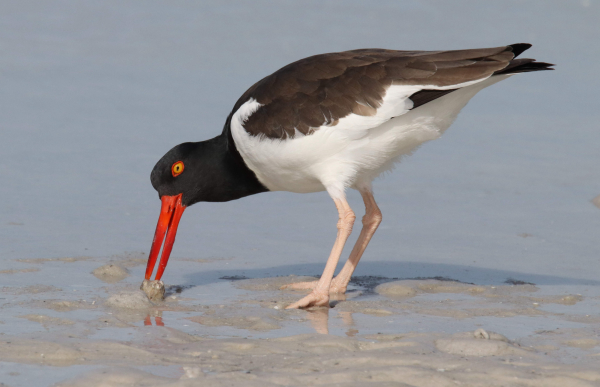
I was immediately affected by the birds, their stately appearance, their trusting nature, their large size for shorebirds, and their photographability – they looked good in photos, filled the photo frame, and acted as if I wasn’t there, or as though I was accepted on the edge of their space. Not just me, Jim and other birders, photographers, and interested people headed for the beach too.
The only negative was that the birds didn’t show their wings, either by stretching, flapping, or taking a little flight; well actually, one of the oystercatchers did spread its wings at one point, but I almost missed the opportunity to photograph it with its wings raised. By the time I saw that quick action and reacted to it I managed just a single photo of the bird as it was starting to fold its wings. The bird was twisted away from me a bit, so the image wasn’t great, but it provided another view of the birds and a bit more of variety among my photos.
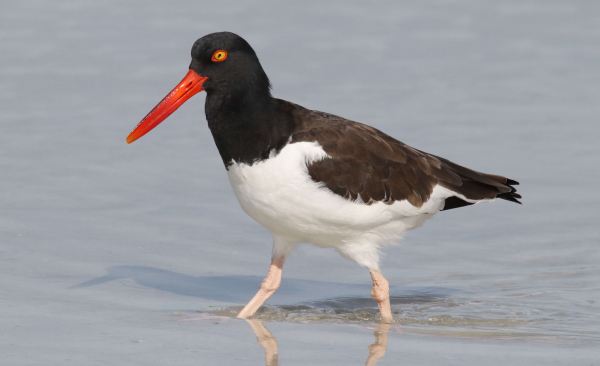
Even after an extended period of photographing, it was hard for me to break away from the oystercatcher pair, but there were many other birds to photograph along the shore of the lagoon on the backside of the Gulf beach. Hoping to find the oystercatchers when I returned to photograph 3 days later, a storm that passed through the previous day seemed to have chased most shorebirds from the area, all except a small flock of Snowy Plovers, a new find for last February, and even they were trying to shelter from the stout onshore wind. I didn’t have a chance to return to the oystercatcher lagoon during that trip, but I hoped I would cross paths with American Oystercatchers another time – they really impressed me.
The New Year
Would I find oystercatchers during my New Year’s photo visits to Desoto and oystercatcher lagoon? I didn’t find any there during my December 30th and 31st visits, even though the New Years Eve day visit proved to be an exceptional period for photographing wintering shorebirds. In fact, I took so many photographs that afternoon that my battery went dead at the end of the day – a first while using the this camera. I enjoyed that day of photographing sooo much, that I had to return to Desoto the day after New Years Day.
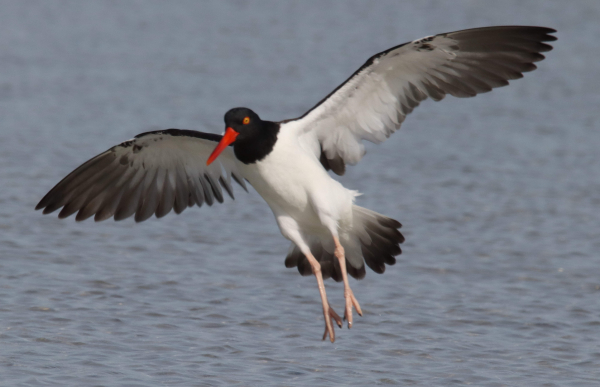
That morning was graced by what I imagine was a quality of light that was as good as it gets, and after photographing a surprise Wood Stork not far from Rose and Jim’s house, I continued on to Desoto and began photographing at oystercatcher lagoon – or was it oystercatcher-less? Along the lagoon, located behind the beach at the north end of the park road, the birds were mostly the same as I’d encountered 2 days earlier – many, many Piping Plovers, Snowy Plovers, Semipalmated Plovers, Black-bellied Plovers, Sanderlings, Dunlins, a few Red Knots and Semipalmated Plovers, and a lone Marbled Godwit.
After a couple hours of photographing and observing shorebirds, I scanned farther ahead and suddenly noticed an exciting and familiar bird – an American Oystercatcher. The oystercatcher received my immediate attention and I picked up my walking pace to get closer while the bird was foraging along a shallow finger of water that connected to the lagoon. Taking a number of photos of the oystercatcher during my approach, I reveled at the chance to photograph the species again. Without question, the oystercatcher measured up to be a larger, bulkier, more colorful, and even more stately subject, a most impressive bird surrounded by a variety of other shorebirds.
The lighting was clearly as good as it gets, and as I reached a good vantage point I settled in to photograph as the oystercatcher as it foraged in the shallows and along the sandy shoreline. After an initial photo sequence, the oystercatcher acted like so many shorebirds along the perimeter of the lagoon, it walked closer! Not directly, but it foraged in my direction until it was filling the photo frame of my camera and I had to zoom the magnification of my lens back a bit to keep a balance of surrounding landscape and the bird in the photo frame.
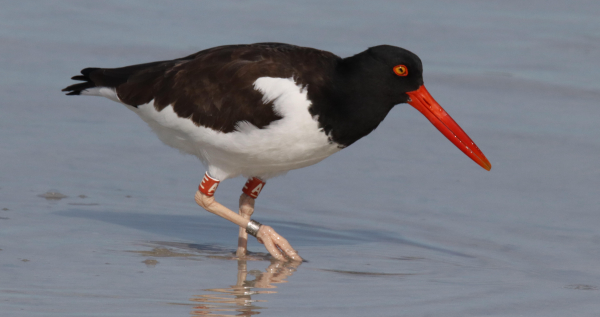
It’s truly fulfilling when birds act in such a trusting manner, and I certainly did nothing for it to question that trust – only following its movements with my long black camera lens pointing in its direction. Eventually, I did need to follow the oystercatcher’s route; actually, I needed to stay a bit ahead of it to utilize the best direction of the light, with my shadow pointing directly at the oystercatcher. In this way, I also gave the bird more space to move in my direction if it chose to. If it reversed direction, I eventually followed it, giving it plenty of space and waiting for it to turn my way or to the side.
Camera Settings: I was using an ISO setting of 800, with an aperture of f-10, which created a very fast shutter speed of 1/2000 for most photos, but varying to 1/2500 – more than fast enough to stop all action on the beach. At one point as I was photographing, I switched the ISO setting from 800 to 400; at the time it seemed as though it might be overkill to be using an 800 ISO setting. For more information about individual photos, as always I include the specific camera settings for each photo that illustrates this article.
During a momentary break, I looked around the area to ascertain if there was another oystercatcher within sight, and that’s when I saw a second American Oystercatcher resting on a small, barely exposed sandbar. Were the 2 birds connected? I didn’t see any other oystercatchers, and in a few minutes the bird I was photographing began wading into deeper water, headed toward the other oystercatcher. When it arrived adjacent to the resting bird, there was no interaction, and the oystercatcher I was photographing merely stopped, rested its bill on its back, lifted one leg up, and joined the siesta.
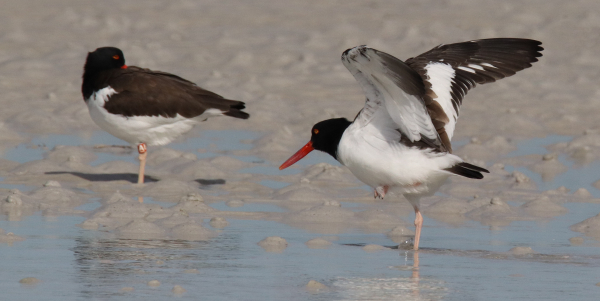
I checked the other bird to see if it was banded, but it didn’t look like it initially. The oystercatchers were really too far away to take effective photos, so having taken a wealth of quality photos already, I gave them some time to rest as little plovers foraged nearer until they were running near at my feet (Amazing!) At one point I saw the first oystercatcher open its wings and hop forward, which made me try to photograph the action from a distance. It turned out to be quite funny to watch as I realized the big shorebird was hopping with just one foot, keeping the other leg tucked under its body. A couple times it even flapped its wings to make a bigger jump, but all one-legged – ha!
Eventually the first oystercatcher waded back to the finger of water where it was foraging before and I repositioned to photograph again. This time, in the midst of photographing, a tiny Sanderling began following the oystercatcher, double-checking the shallow water where the oystercatcher probed as it waded in the shallows, as if the Sanderling might find a small morsal of food overlooked or ignored by the much larger oystercatcher. A second Sanderling soon followed, checking shells for food after the oystercatcher pried open a small clam and ate the larger animal parts.
Soon there was a little Snowy Plover watching, and a larger Black-bellied Plover too. This was an interesting behavioral sequence, especially considering that the oystercatcher never seemed to acknowledge the activities of the other birds; apparently it was used to this non-reciprocal relationship. But suddenly the oystercatcher became alert and took flight back toward the other oystercatcher, and I followed its flight through my camera lens, waiting for the right positioning to try for a flight photo. As it turned out, the oystercatcher landed between its apparent mate and 3 gulls that landed in the shallows near the second oystercatcher. Without a sound or other action, the gulls took flight and left – a Laughing Gull, a Ring-billed Gull, and a young Herring Gull.
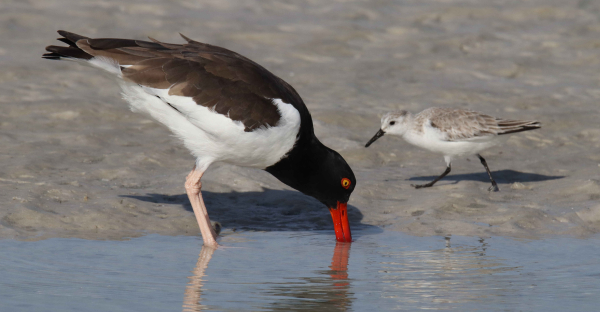
I turned away for a moment, distracted by the close approach of a Piping Plover, and when I looked up again both oystercatchers were flying toward me and the finger of water where the first oystercatcher had been feeding. I immediately focused on one of the oystercatchers, and as it dropped its legs and spread its wings wide to land, I managed my best photo of an American Oystercatcher in flight – a real breakthrough! Now both oystercatchers were close and headed my way, and I could immediately see the second bird was banded with red leg bands that positively showed me this was the female I photographed a year earlier, and that this was the same trusting pair I enjoyed photographing and spending time with for last February.
After another photo session with the pair of American Oystercatchers, my Desoto birding experience was complete and I reveled at the opportunity to spend time with such an unfathomable collection of shorebirds – oh what fun I had! Luckily for bird photographers, there are large concentrations of birds found in locations spread across much of North America. It’s a great time of the year to consider going a bit farther afield than usual to check out a winter birding hotspot, hoping to create a photo session to remember. It may include flocks of birds, or individuals, but considering how enjoyable a single American Oystercatcher and its banded mate were to observe and photograph, 1 or 2 birds can make any winter birding efforts a memorable experience. Add to that hundreds of other shorebirds, and it becomes what dreams are made of – Enjoy!
Article and photographs by Paul Konrad
Share your bird photos and birding experiences at editorstbw2@gmail.com